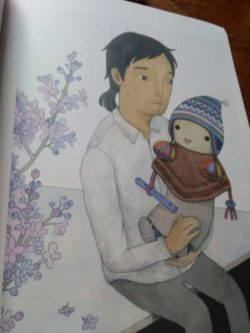Teaching The Ventriloquist's Daughter (2)
We are delighted that our Teaching Consultant and Advisory  Board member Dr Theresa Munford, of St Gregory's School in Bath, has created a blog series for us on the practicalities of using an authentic text to create a Y10 scheme of work. The text she has chosen is The Ventriloquist’s Daughter by Lin Man-chiu, translated by Helen Wang.
Board member Dr Theresa Munford, of St Gregory's School in Bath, has created a blog series for us on the practicalities of using an authentic text to create a Y10 scheme of work. The text she has chosen is The Ventriloquist’s Daughter by Lin Man-chiu, translated by Helen Wang.
Part 2. 9th June 2018
Lesson 2: Using the text for writing revision
Rationale
This will be our last session before their Y10 exam so I need it to be focussed on something useful for their revision. Their writing paper will be modelled on the new GCSE writing specification and will include an option to write a description of a person. This lesson, therefore, is geared to writing practice, specifically using sentence patterns and vocabulary to do with physical appearance and clothes.
However, I try to start as many lessons as possible with a very quick, minimum-preparation listening exercise, (mostly using news items from The Chairman’s Bao, Level 1 or Level 2), as I think listening is a skill we sometimes undervalue in the MFL classroom. I’ve decided that as The Ventriloquist’s Daughter will take them to South America, the listening we will do in the coming term will be linked to various countries there. For this one, I found a good one-minute piece on The Chairman’s Bao about a Columbian man finding a stash of money, the vocabulary is mostly simple and familiar to them.

The main writing task in the lesson is, effectively, drawing on work they’ve done so far in their text book. The image I want them to describe is from the OT of The Ventriloquist’s Daughter. It’s a pity the English text doesn’t have the same wonderful illustrations.
Finally, in the plenary we’ll look at one or two of Lin Man-chiu’s descriptions as a way of them encountering, but hopefully not being intimidated by, an authentic literary text.
Review
Again, they engaged really well with the task. They enjoyed the listening tasks and managed to guess the meaning of 藏 from the context.
They all managed to write at least one sentence about the doll and the father, and we shared these. There was quite an interesting discussion about whether you could use 长得 with an inanimate object like a doll.
We only had time to look at one paragraph from the OT, the description of the father as Liu-er first sees him in the forest on his return. My Chinese colleague read the passage slowly out to them, they followed it with the English text alongside the photocopy of the Chinese text. Then we went slowly through it sentence by sentence. I told them I was not expecting them to understand it in detail, but more to spot words or sentence patterns they could recognise or guess at.
They quickly noticed how words are repeated to aid description (细细瘦瘦, 闪闪) and they seemed pleasantly surprised at how many characters they recognised. There was an interesting discussion of the choice of the word ‘beige’ to describe 土黄色 for Baba’s trousers – the idea of ‘yellow earth’ being an unfamiliar one to a lot of British people where the earth is not that colour! This led to a discussion about whether the word ‘khaki’ would work instead of beige or if this was too specific and military. We also got into a discussion about 光 and the three different ways it appears in this short paragraph. (发光, 目光, 阳光).
As with the last lesson, it has been really interesting seeing the text through the students’ eyes and realising how much intercultural learning they can get even from just a few sentences.
There’ll be a break of a week for their exams and then hopefully we can do lots more creative work based on The Ventriloquist’s Daughter for the rest of the term!
Downloads
Lesson 2 handout of descriptions
To be continued...
